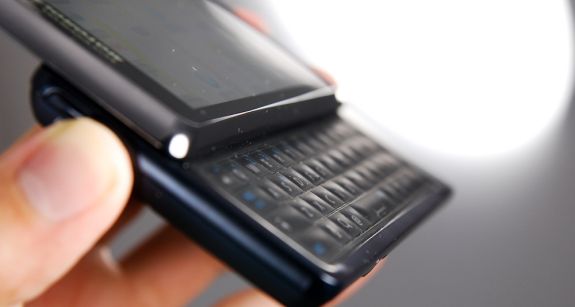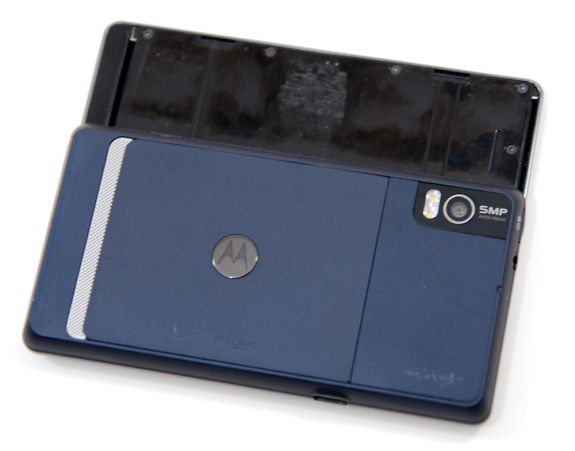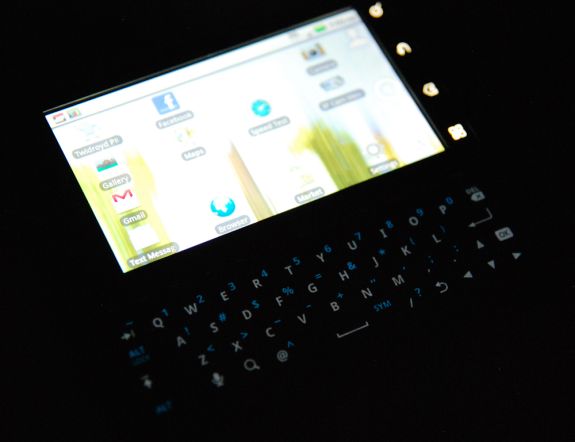Motorola Droid 2 Review: Rebooting the Droid
by Brian Klug on September 19, 2010 7:00 AM EST- Posted in
- Smartphones
- Droid
- Motorola Droid 2
- Android
- Mobile
Finally, a usable hardware keyboard
Of course, what’s really changed about the Droid 2 is the keyboard. I reviewed the original Droid a while back, and talked a lot about why I found the first Droid’s keyboard frustrating to the point of being unusable. What I was missing however was perspective on the original Droid’s refreshed keyboard, which has somewhat raised keys, and thus much better feedback.
If you’re contemplating upgrading from the original device, just how much better the Droid 2’s keyboard will feel to you is purely a function of which revision of the original Droid you’re coming from. If you were an early adopter and got the first one, the difference is dramatic to the point of earth shattering. Most people I know with the first revision, concave-key sporting version don’t even use the hardware keyboard. However, if you’ve already got a later revision from hopping onboard later or RMA, the difference isn’t nearly as dramatic.

Motorola Droid (original) Keyboard
The oversized Dpad is gone, which is good for most things as it just didn’t serve much purpose in Android, but did have get use in some game emulators and other programs. Android developers are likely going to build interaction paradigms around whatever inputs are present on a majority of devices, and there just doesn’t seem to be a majority of Android handsets with Dpads or optical trackpads. You’re not totally screwed if you needed directional controls, however, as the Droid 2 maintains up down left and right keys in the bottom right. What’s really nice about the Droid 2 keyboard is that the space picked up from ditching the DPad has been put to really good use. The keyboard is arranged in an offset pattern just like a real QWERTY keyboard should be.
The domes themselves are also convex, just like they always should have been. Even better are raised bars on j and f for index finger placement—again, just like a real keyboard.
There are dedicated search, microphone input, back, and ok buttons as well. The result is that with the exception of home, all of the capacitive buttons are present in landscape mode as well. There’s alt-lock in the place of caps lock, which is a bit odd, but everything you’d expect is here.
The keyboard slider assembly is likewise unchanged from the original Droid. There’s no spring assist—just friction. There are thankfully two clicks for keeping the phone in the closed or open position, but nothing more. Sliding the tray open and closed is smooth, but not very.
After a week of use—greasy glossy back and scrapes from sliding mechanism
I don’t think anyone will complain about it, and don’t get me wrong—it isn’t a problem—but I’m left wondering why Motorola seriously couldn’t add two strips of Teflon to the slider and make it feel smooth as glass. HTC has done it forever.
As it stands, you can clearly see the slider assembly making marks on the glossy back of the display, which begs another question: why the heck is this so glossy? Regardless, the addition of some teflon would make the Droid 2’s slider rightfully feel like a piece of precision engineering or an expensive micrometer. Otherwise, it feels forced and a bit cheap. There’s also one or two degrees of oreo effect when the keyboard tray is closed. In the open position, the mechanism is completely solid.
The Droid 2's backlighting is adequate, but just a bit understated. I didn't have problems finding keys in the dark, but they're not super bright, just lit.
On the whole, the Droid 2 feels much the same as the original device. What’s different is that Motorola has worked out the few hardware oddities (like that chin at the bottom) and smoothed over the hardware’s rough spots. Literally smoothed over—the 2 has gracefully rounded edges along the outside and slightly longer radius curves in most others.
The result is probably the most optimal balance between ties to the old Droid and a much needed refresh.














39 Comments
View All Comments
bigi - Tuesday, September 21, 2010 - link
Your pics in the sun are crap because left/middle phones have photographer shadow on them therefore showing more contrast/details in shaded area.The phone on the right looks worst because the "photographer" made this look worst.
awaken688 - Tuesday, September 21, 2010 - link
Brian. Good review. Can you comment on how the Droid 2 works as a phone? You know the earpiece volume and clarity? Ability to get rid of background noise of the receiving speaker. I know these are smartphones, but they still are phones so I would love to have some clear thoughts on that part of the device.LoneWolf15 - Tuesday, September 21, 2010 - link
In a week and a half, I can only comment on my own experience --but the D2 has the best reception and call clarity of the smartphones I've had (Kyocera 7135, three Treos, and a Blackberry Tour prior to this). I've gotten calls (and held them) in areas I thought previously impossible, and calls everywhere for me have been clear.Brian Klug - Tuesday, September 21, 2010 - link
I generally don't comment too much on handset performance unless there's something extraordinarily bad about performance, purely because it's very subjective right now. In this case, Droid 2 handset quality/volume are almost identical to the original Droid. Both have noise cancellation, though I'm betting the Droid 2 is slightly less effective at cancelling noise due to that (as I mentioned) somewhat strange rear microphone placement.Otherwise I've been working on a very quantitative way to judge handset voice quality and performance, which will eventually appear in reviews. Subjectively, the Droid 2 is the same as any CDMA phone in terms of voice quality.
-Brian
DJMiggy - Wednesday, September 22, 2010 - link
Good review! Lots of good information on the Droid 2. I look forward to the ARM Cortex-A9 MPCore. March 2011 is when my new every two is up with Verizon and I can get a new phone without getting bunged 600 dollars. lolawaken688 - Wednesday, September 22, 2010 - link
Thanks LoneWolf and Brian. I just know that from my experience with the LG VX8300 that not all CDMA/GSM phones are created equal. We have an original Droid and it is by far the best phone we have used. It's clarity, volume, and reception is just hands down better than my VX8300 and it easily bests the iPhone we have too, although it is by a less noticeable amount.I'll take subjective =)
Shinobi123 - Friday, October 1, 2010 - link
Why is the XT720 never in these comparisons?I've had this phone for soon two months, and it's easily the best phone I ever had.
Not biggest screen or highest clocked cpu, but it's a good phone and excellent camera.
soccerharms - Friday, October 1, 2010 - link
Hey Brian,Is there future plans to compare the droid x with froyo with the droid 2? I would be very interested in how these stack up because people are posting significant performance increases with the update.
Thanks for the review
jeans_xp - Wednesday, October 20, 2010 - link
The mobile world's yesterday king is backing.HAHA, first smart phone is iPhone 3GS. I find a good website for smart phone news and latest technology: www.mobilegoing.com